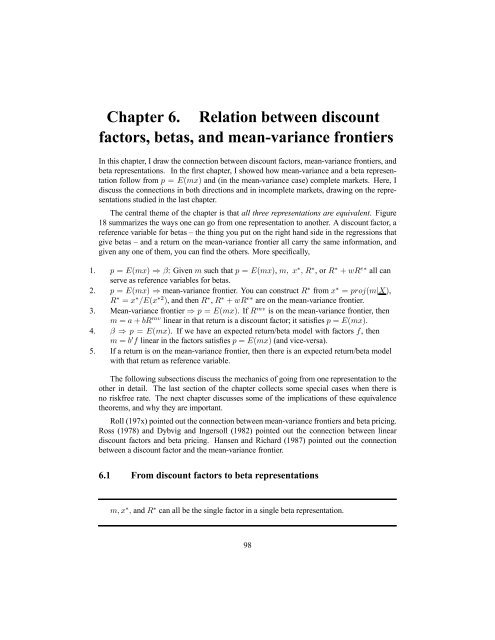Asset Pricing John H. Cochrane June 12, 2000
Asset Pricing John H. Cochrane June 12, 2000
Asset Pricing John H. Cochrane June 12, 2000
You also want an ePaper? Increase the reach of your titles
YUMPU automatically turns print PDFs into web optimized ePapers that Google loves.
Chapter 6. Relation between discount<br />
factors, betas, and mean-variance frontiers<br />
In this chapter, I draw the connection between discount factors, mean-variance frontiers, and<br />
beta representations. In the first chapter, I showed how mean-variance and a beta representation<br />
follow from p = E(mx) and (in the mean-variance case) complete markets. Here, I<br />
discuss the connections in both directions and in incomplete markets, drawing on the representations<br />
studied in the last chapter.<br />
The central theme of the chapter is that all three representations are equivalent. Figure<br />
18 summarizes the ways one can go from one representation to another. A discount factor, a<br />
reference variable for betas – the thing you put on the right hand side in the regressions that<br />
give betas – and a return on the mean-variance frontier all carry the same information, and<br />
given any one of them, you can find the others. More specifically,<br />
1. p = E(mx) ⇒ β: Givenm such that p = E(mx), m, x ∗ ,R ∗ ,orR ∗ + wR e∗ all can<br />
serve as reference variables for betas.<br />
2. p = E(mx) ⇒ mean-variance frontier. You can construct R ∗ from x ∗ = proj(m|X),<br />
R ∗ = x ∗ /E(x ∗2 ),andthenR ∗ , R ∗ + wR e∗ are on the mean-variance frontier.<br />
3. Mean-variance frontier ⇒ p = E(mx). IfR mv is on the mean-variance frontier, then<br />
m = a + bR mv linear in that return is a discount factor; it satisfies p = E(mx).<br />
4. β ⇒ p = E(mx). If we have an expected return/beta model with factors f, then<br />
m = b 0 f linear in the factors satisfies p = E(mx) (and vice-versa).<br />
5. If a return is on the mean-variance frontier, then there is an expected return/beta model<br />
with that return as reference variable.<br />
The following subsections discuss the mechanics of going from one representation to the<br />
other in detail. The last section of the chapter collects some special cases when there is<br />
no riskfree rate. The next chapter discusses some of the implications of these equivalence<br />
theorems, and why they are important.<br />
Roll (197x) pointed out the connection between mean-variance frontiers and beta pricing.<br />
Ross (1978) and Dybvig and Ingersoll (1982) pointed out the connection between linear<br />
discount factors and beta pricing. Hansen and Richard (1987) pointed out the connection<br />
between a discount factor and the mean-variance frontier.<br />
6.1 From discount factors to beta representations<br />
m, x ∗ , and R ∗ can all be the single factor in a single beta representation.<br />
98
















